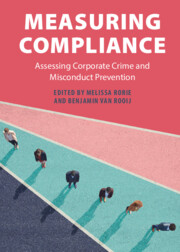38 results
Contributors
-
- Book:
- Measuring Compliance
- Published online:
- 17 February 2022
- Print publication:
- 24 February 2022, pp ix-xii
-
- Chapter
- Export citation
12 - Admitting Noncompliance: Interview Strategies for Assessing Undetected Legal Deviance
- from Part 3 - Qualitative Approaches to Measuring Corporate Compliance
-
-
- Book:
- Measuring Compliance
- Published online:
- 17 February 2022
- Print publication:
- 24 February 2022, pp 202-217
-
- Chapter
- Export citation
Copyright page
-
- Book:
- Measuring Compliance
- Published online:
- 17 February 2022
- Print publication:
- 24 February 2022, pp iv-iv
-
- Chapter
- Export citation
Contents
-
- Book:
- Measuring Compliance
- Published online:
- 17 February 2022
- Print publication:
- 24 February 2022, pp v-vi
-
- Chapter
- Export citation
Tables
-
- Book:
- Measuring Compliance
- Published online:
- 17 February 2022
- Print publication:
- 24 February 2022, pp viii-viii
-
- Chapter
- Export citation
Part 2 - Quantitative Approaches to Measuring Corporate Compliance
-
- Book:
- Measuring Compliance
- Published online:
- 17 February 2022
- Print publication:
- 24 February 2022, pp 91-186
-
- Chapter
- Export citation
Part 1 - The Compliance Industry, the State, and Measurement Needs
-
- Book:
- Measuring Compliance
- Published online:
- 17 February 2022
- Print publication:
- 24 February 2022, pp 23-90
-
- Chapter
- Export citation
13 - Compliance Ethnography: What Gets Lost in Compliance Measurement
- from Part 3 - Qualitative Approaches to Measuring Corporate Compliance
-
-
- Book:
- Measuring Compliance
- Published online:
- 17 February 2022
- Print publication:
- 24 February 2022, pp 218-238
-
- Chapter
- Export citation
Figures
-
- Book:
- Measuring Compliance
- Published online:
- 17 February 2022
- Print publication:
- 24 February 2022, pp vii-vii
-
- Chapter
- Export citation
Part 3 - Qualitative Approaches to Measuring Corporate Compliance
-
- Book:
- Measuring Compliance
- Published online:
- 17 February 2022
- Print publication:
- 24 February 2022, pp 187-238
-
- Chapter
- Export citation
Index
-
- Book:
- Measuring Compliance
- Published online:
- 17 February 2022
- Print publication:
- 24 February 2022, pp 302-312
-
- Chapter
- Export citation
1 - Measuring Compliance: The Challenges in Assessing and Understanding the Interaction between Law and Organizational Misconduct
-
-
- Book:
- Measuring Compliance
- Published online:
- 17 February 2022
- Print publication:
- 24 February 2022, pp 1-22
-
- Chapter
- Export citation
Part 4 - Mixed Methods and Building on Existing Compliance Research
-
- Book:
- Measuring Compliance
- Published online:
- 17 February 2022
- Print publication:
- 24 February 2022, pp 239-301
-
- Chapter
- Export citation

Measuring Compliance
- Assessing Corporate Crime and Misconduct Prevention
-
- Published online:
- 17 February 2022
- Print publication:
- 24 February 2022
Part IX - Analysis of Particular Fields
-
- Book:
- The Cambridge Handbook of Compliance
- Published online:
- 07 May 2021
- Print publication:
- 20 May 2021, pp 797-798
-
- Chapter
- Export citation
35 - The Opportunity Approach to Compliance
- from Part V - Capacity and Opportunity
-
-
- Book:
- The Cambridge Handbook of Compliance
- Published online:
- 07 May 2021
- Print publication:
- 20 May 2021, pp 516-528
-
- Chapter
- Export citation
Part V - Capacity and Opportunity
-
- Book:
- The Cambridge Handbook of Compliance
- Published online:
- 07 May 2021
- Print publication:
- 20 May 2021, pp 465-528
-
- Chapter
- Export citation
32 - Do People Know the Law? Empirical Evidence about Legal Knowledge and Its Implications for Compliance
- from Part V - Capacity and Opportunity
-
-
- Book:
- The Cambridge Handbook of Compliance
- Published online:
- 07 May 2021
- Print publication:
- 20 May 2021, pp 467-488
-
- Chapter
- Export citation
Contributors
-
- Book:
- The Cambridge Handbook of Compliance
- Published online:
- 07 May 2021
- Print publication:
- 20 May 2021, pp xiv-xviii
-
- Chapter
- Export citation
1 - Introduction: Compliance as the Interaction between Rules and Behavior
-
-
- Book:
- The Cambridge Handbook of Compliance
- Published online:
- 07 May 2021
- Print publication:
- 20 May 2021, pp 1-10
-
- Chapter
- Export citation

